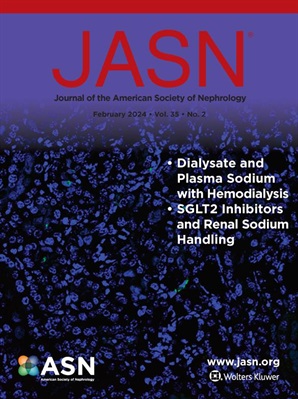氯菌素过量诱导的过氧化物酶体结构改变和AKI可通过肾吲哚解毒剂(INMT)预防。
IF 10.3
1区 医学
Q1 UROLOGY & NEPHROLOGY
引用次数: 0
摘要
背景:新型钙调磷酸酶抑制剂(CNI) voclosporin治疗狼疮性肾炎有效,但与急性肾损伤(AKI)相关的机制在很大程度上未知。voclosporin诱导的AKI显示,voclosporin降低吲哚乙胺n-甲基转移酶(Inmt)的表达,Inmt是一种负责解毒局部尿毒症毒素如吲哚的酶。本研究探讨Inmt过表达是否对高剂量氯菌素诱导的AKI具有保护作用。本研究使用基因工程小鼠来探索Inmt在氯菌素诱导的AKI中的作用。方法采用转染过表达Inmt小鼠和条件敲除(conditional KO)小鼠模型评估肾近端小管特异性Inmt功能。通过RNA测序、组织病理学和各种分子检测检测基因表达变化、凋亡细胞百分比和线粒体DNA拷贝数。这些分析进一步辅以免疫荧光和电子显微镜来研究细胞和结构的变化。人类临床标本也进行了调查。结果在条件性KO小鼠中观察到,高剂量氯菌素诱导AKI的sinmt下调与过氧化物酶体和线粒体数量和功能减少、活性氧产生增加和小管凋亡增加有关。然而,在用氯菌素处理的转基因小鼠中,过氧化物酶体和线粒体的完整性得以保留。值得注意的是,电子显微镜显示,在小鼠和人类cni诱导的AKI标本中观察到的结构过氧化物酶体变化在高剂量voclosoprin处理的转基因小鼠中被逆转。总的来说,近端小管特异性Inmt过表达通过促进过氧化氢酶上调、降低H2O2水平和恢复过氧化物酶体功能来保护高剂量氯菌素诱导的AKI。结论近端小管sinmt过表达可预防高剂量氯菌素引起的结构改变和AKI。本文章由计算机程序翻译,如有差异,请以英文原文为准。
Voclosporin Overdose-Induced Peroxisomal Structural Changes and AKI Are Prevented by Renal Indole Detoxifier, INMT.
BACKGROUND
The novel calcineurin inhibitor (CNI) voclosporin is effective in treating lupus nephritis but has been associated with acute kidney injury (AKI) through largely unknown mechanisms. Voclosporin-induced AKI revealed that voclosporin reduces the expression of indolethylamine N-methyltransferase (Inmt), an enzyme responsible for detoxifying local uremic toxins such as indole. This study investigates whether Inmt overexpression can protect against high-dose voclosporin-induced AKI. This study used genetically engineered mice to explore the role of Inmt in voclosporin-induced AKI.
METHODS
Transgenic mice overexpressing Inmt and conditional knockout (conditional KO) mouse models were used assess renal proximal tubule-specific Inmt function. Gene expression changes, apoptotic cell percentages, and mitochondrial DNA copy numbers were examined through RNA sequencing, histopathology, and various molecular assays. These analyses were further complemented with immunofluorescence and electron microscopy to investigate cellular and structural changes. Human clinical specimens were also investigated.
RESULTS
Inmt downregulation in high-dose voclosporin-induced AKI was associated with reduced peroxisome and mitochondrion numbers and function, increased production of reactive oxygen species, and increased tubular apoptosis, as observed in conditional KO mice. However, in transgenic mice treated with voclosporin, peroxisomal and mitochondrial integrity were preserved. Notably, electron microscopy revealed that the structural peroxisomal changes observed in mouse and human CNI-induced AKI specimens were reversed in high-dose voclosoprin-treated transgenic mice. Overall, proximal tubule-specific Inmt overexpression protects against high-dose voclosporin-induced AKI by promoting catalase upregulation, reducing H2O2 levels, and restoring peroxisomal function.
CONCLUSIONS
Inmt overexpression in proximal tubules prevented high-dose voclosporin-induced structural changes and AKI.
求助全文
通过发布文献求助,成功后即可免费获取论文全文。
去求助
来源期刊
CiteScore
22.40
自引率
2.90%
发文量
492
审稿时长
3-8 weeks
期刊介绍:
The Journal of the American Society of Nephrology (JASN) stands as the preeminent kidney journal globally, offering an exceptional synthesis of cutting-edge basic research, clinical epidemiology, meta-analysis, and relevant editorial content. Representing a comprehensive resource, JASN encompasses clinical research, editorials distilling key findings, perspectives, and timely reviews.
Editorials are skillfully crafted to elucidate the essential insights of the parent article, while JASN actively encourages the submission of Letters to the Editor discussing recently published articles. The reviews featured in JASN are consistently erudite and comprehensive, providing thorough coverage of respective fields. Since its inception in July 1990, JASN has been a monthly publication.
JASN publishes original research reports and editorial content across a spectrum of basic and clinical science relevant to the broad discipline of nephrology. Topics covered include renal cell biology, developmental biology of the kidney, genetics of kidney disease, cell and transport physiology, hemodynamics and vascular regulation, mechanisms of blood pressure regulation, renal immunology, kidney pathology, pathophysiology of kidney diseases, nephrolithiasis, clinical nephrology (including dialysis and transplantation), and hypertension. Furthermore, articles addressing healthcare policy and care delivery issues relevant to nephrology are warmly welcomed.

 求助内容:
求助内容: 应助结果提醒方式:
应助结果提醒方式:


